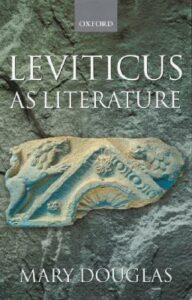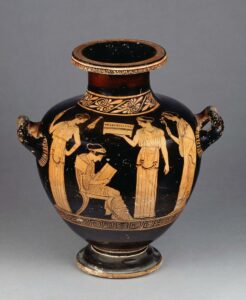 A question that for many years sat half-hidden, rarely if ever articulated, in the back of my mind — and no doubt in the minds of many readers with some awareness of ancient history: When did any culture in the ancient Levant start writing “books” as we would recognize them in, say, the first five books of the Old Testament?
A question that for many years sat half-hidden, rarely if ever articulated, in the back of my mind — and no doubt in the minds of many readers with some awareness of ancient history: When did any culture in the ancient Levant start writing “books” as we would recognize them in, say, the first five books of the Old Testament?
It turns out that this question is discussed in a couple of contributions to a volume addressing the anthropologist Mary Douglas‘s insights into the literary structure of the book of Leviticus: Reading Leviticus. A Conversation with Mary Douglas, edited by John F. A. Sawyer.
Now Leviticus is certainly constructed with very ancient — “pre-book” — stylistic features, in particular, the “ring composition”. As Douglas explains:
In Leviticus’ favourite literary form, chiastic composition, the meaning is at the pivot or the middle of a series of parallel verses. On either side of the sections on leprosy there stand supporting verses on human reproduction like steps or like framing pillars. Within the series on a leprous person, two additional afflicted objects are introduced, a leprous garment, and a leprous house. The alternation makes an a–b–a–b pattern as follows:
a Leprosy of a person, diagnosis, 13: 1–46
b Leprosy of a garment, diagnosis, 13: 47–59
a′ Leprosy of a person, declaring clean and atonement, 14: 1–32
b′ Leprosy of a house, diagnosis and cleansing, atonement, 14: 47–53When body, garment, and house are found in a carefully constructed set of rules, we have been warned. It signals a return to the body/temple microcosm. The reading is also returned to the early conceit of the ‘house-that-Jack-built’, the concentric pattern of one thing placed upon another and another. (p. 177)
An old technique for creating focus is to set up a series of concentric circles. Leviticus frequently places parallel cases in ascending order, so that the last includes the second and the second includes the first. They can be run backwards or forwards with the closure at either end. It is a very ancient formula. In Mesopotamia in the classical period, 2000 to 1500 BCE, the following magic incantation was recommended to wash a mote out of the eye:
Earth, they say, earth bore mud,
mud bore stalk,
stalk bore ear,
ear bore mote, . . .
the mote entered the young man’s eye.
A modern Hebrew example of concentric incorporation is the old doggerel recited by the children at the Passover ceremony:
Only one kid, only one kid, which my father bought for two zuzim . . .
And a cat came and ate the kid, which my father bought for two zuzim; only one kid, only one kid.
And a dog came and bit the cat which ate the kid, etc.
And a stick came and beat the dog which bit the cat which ate the kid, etc.The English parallel is ‘The House that Jack Built’, which ends with a grand inclusive finale:
This is the stick that beat the dog, that bit the cat, that killed the rat, which ate the grain which lay in the house that Jack built.
Leviticus applies something very like this literary trope in a slow and measured fashion to the layers inside the body of a living being, and also to the body’s outer coverings. . . . (p. 54)
So Leviticus does in one sense remind readers of the earliest written compositions such as poetic epics that employed “ringing” or “concentric circle” techniques that were apparent aides to memory for oral performance. The term parallelism has been coined to discuss this very ancient and universal technique:
So far from being a local Semitic style, parallelism also governs the form of millennia-old Chinese poetry [Zongqi] and is found in oral literature throughout the world [Fox]. (p. 48)
We cannot deny that Leviticus is marked with some very ancient techniques. But it is still unlike any other “book” from very ancient times. It is not like an epic poem or list of proverbs that was constructed with such parallelism to assist the memory of the reciter.
Rolf Rendtorff responds to Mary Douglas’s analysis of Leviticus by delineating the characteristics that make it a standalone “book” even though it contains thematic links binding it to the other four books of the Pentateuch. It is a self-contained narrative about the Jerusalem cult and it is made up of a coherent structure, beginning, end, and middle, with the various parts threaded together with structures, themes and images that make it an organic whole.

Kathryn Gutzwiller continues Rendtorff’s discussion but her contribution is as a classicist, an outsider to biblical studies. For Gutzwiller it is important to distinguish the employment of ring composition from the creation of a book per see.
. . . I find another distinction to be necessary as well, one that separates the process of ring composition from the concept of the book.
In modern terms, the word ‘book’ has two different meanings that seem relevant to the topic at hand. The word refers to a physical entity, to pages bound in a volume, but a book is also an intellectual concept, that which is composed to be read as an integrated unit. While the physical entity and the intellectual construct normally correspond, this is not always the case, so that we may have a long book published in two or more volumes, each a ‘book’ in the physical sense. A similar situation prevailed in the ancient world. . . . Books in [the physical] sense existed in Greece at least as early as the beginning of the sixth century, a period of time when the Greeks had extensive contacts with Egyptian culture.
So when did books “in the intellectual sense” begin to appear?
The point at which the Greeks began to compose texts to fit upon a papyrus roll, and so to be books in both senses of the word, is difficult to determine. In all likelihood, the rise of prose literature in the late fifth century is connected with this phenomenon. (p. 37)
We easily think of Herodotus, the historian. Kathryn Gutzwiller suggests Herodotus was a transitional figure. Yes, he wrote an extensive history in prose, but we also know that there were oral presentations of portions of his Histories.
Soon afterwards we have the historian Thucydides who would have none of Herodotus’s popular “tricks”. His work, he announced in his opening, was not a pop piece to entertain for a moment but rather a monument to last forever.
I have written my work, not as an essay which is to win the applause of the moment, but as a possession for all time. (1.22.4)
Books — in both the physical and intellectual sense — began to appear in the Hellenistic era, explains KG: Continue reading “Another (major) pointer to a late date for the Pentateuch”
